Marsh D. Applied Geometry for Computer Graphics and CAD
Подождите немного. Документ загружается.


298 Applied Geometry for Computer Graphics and CAD
11.2 Colour
Colours are described in terms of hues that represent distinct colours such as
red, blue or yellow. Artists commonly refer to tints, shades and tones. A tint
is obtained from a hue by adding white. The amount of added white reflects
the level of saturation. For instance a “dark blue” is highly saturated (less
washed-out) while a “light blue” is unsaturated (more washed-out). Similarly,
a shade is obtained by adding black to decrease the intensity or lightness of
the hue. Addition of both white and black to a hue results in a tone.Thereare
several models that are used to specify colour. These include the red, green,
blue (RGB) and the hue, saturation, value (HSV) models used for monitors,
and the cyan, magenta, yellow (CMY) model for printing devices.
The RGB model specifies the amounts of the three primary colours red
r, green g, and blue b, as a coordinate (r, g, b) in a unit cube as shown in
Figure 11.1(a). The primaries are additive meaning that the colours are mixed
to the give the desired colour. Equal amounts of red, green and blue give a
shade of grey ranging from white to black. Greys correspond to points on the
diagonal of the RGB cube with white at (0, 0, 0) and black at (1, 1, 1).
b
lack (0,0,0)
white (1,1,1)
r
g
b
red (1,0,0)
green (0,1,0)
blue (0,0,1)
g
r
e
y
s
h
a
d
e
s
cyan (0,1,1)
yellow (1,1,0)
magenta (1,0,1)
black
blue
cyan
yello
w
white
red
green
magenta
v
s
h
(a) (b)
Figure 11.1 (a) RGB cube, and (b) HSV hexcone
In the RGB cube the “pure” hues are represented by a loop of vertices
(omitting black and white): red-yellow-green-cyan-blue-magenta-red. This leads
naturally to the HSV model for which colour is specified by a coordinate (h, s, v)
to indicate the values of hue h, saturation s, and shade value v. The vertices
are mapped to a plane to form a hexcone as shown in Figure 11.1(b). The
hexcone vertex at (0, 0, 0) represents black and the point (0, 0, 1) represents
white. The hue h specifies the colour in the loop as an angle about the cone
axis with 0
◦
representing red. The saturation s is the distance to the hexcone

11. Rendering 299
axis, and the value v denotes the darkness of the colour given by the distance
in the axis direction. The tints are represented by points in the plane of the
pure hues (shown shaded in Figure 11.1(b)). Points on the planar boundaries
of the hexcone represent shades, and points on the axis joining white and black
represent greys.
Printed colour performs differently to coloured light. For instance, when
white light shines on blue paper, green and red light is absorbed and only
blue light is reflected giving it a blue appearance. Therefore, printed colour is
subtractive, and behaves as a filter removing colour components from the light
that shines on it. The primary colours are cyan c, magenta m, and yellow y,
and specified by the coordinate (c, m, y) in the CMY cube. Cyan, magenta and
yellow absorb the complementary colours red, green and blue, respectively.
A variation of CMY is the CMYK model where the K stands for black. The
motivation for CMYK is that, in reality, cyan, magenta and yellow inks do not
mix to a true black but to a very dark brown. So many colour printers use an
amount of pure black ink k as well as the three primary colours. The CMYK
model represents each colour by a coordinate (c, m, y, k) which is obtained from
the colour’s (c, m, y) coordinate by taking k =min{c, m, y} and replacing c, m,
and y by c − k, m − k,andy − k respectively.
11.3 An Illumination Model for Reflected Light
The light in a scene can originate from either light-emitting sources such as
the sun, light bulbs or a television, or light-reflecting surfaces such as mirrors,
the walls of a room, and objects in a scene. In reality, light emanates from
an area such as the surface of a light bulb or a television screen. This kind of
light is referred to as distributed light. Distributed light is often simplified by
assuming that the light emanates from a point to give a point source.Thisisa
natural simplification to make when the light source is far away or when it is
relatively small in comparison to the objects in the scene. A light source that
is located at infinity produces rays of light that are parallel, and is referred to
as a directional light source. Sunlight is often treated as a directional source.
When light falls on the surface of an object it can be (i) reflected: light
bounces off the surface of the object, (ii) refracted: light passes through the
object, or (iii) absorbed: light does not pass through the object and it is not
reflected. The amalgamation of reflected light from several objects in a scene
is called the ambient or background light. When light is reflected off a sur-
face, it scatters to give diffuse reflection. The light from point sources creates a
highlight or hotspot on a surface called specular reflection. The material prop-
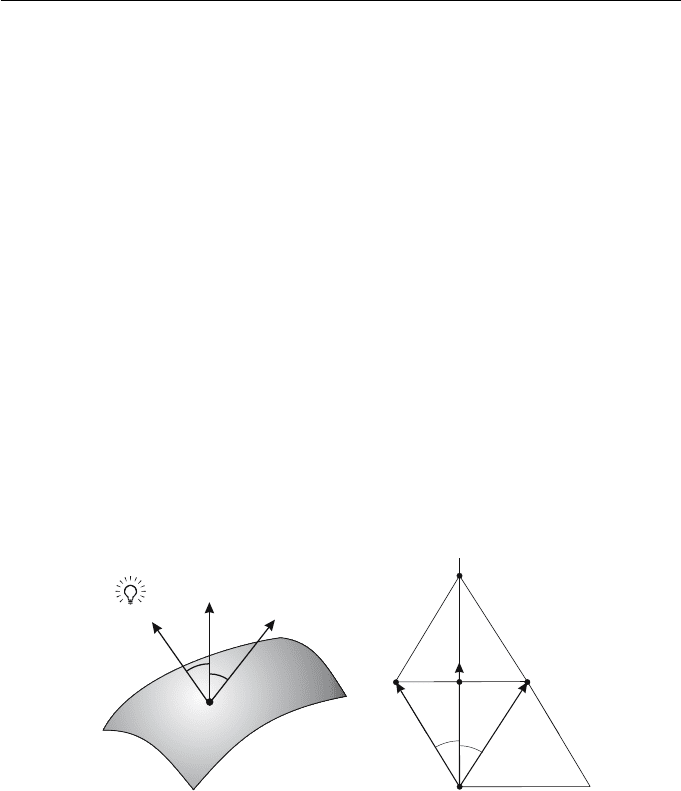
300 Applied Geometry for Computer Graphics and CAD
erties of the object play an important role. Matte objects such as cardboard,
wood, copper and some textiles give little specular reflection. In contrast, shiny
surfaces such as polished metals and mirrors produce many highlights.
Let P be a point of a surface with unit normal N, and let L be the unit
vector pointing to the light source as shown in Figure 11.2(a). The incoming
incident ray is reflected along an outgoing reflected ray R, which is also assumed
to be a unit vector. The angles that the incident and reflected rays make with
the normal are called the angles of incidence and reflection respectively. The
Laws of Reflection state:
Law 1 : The angle of incidence is equal to the angle of reflection.
Law 2 : The surface normal, incident ray and reflected ray lie in the same plane.
Referring to Figure 11.2(b), the reflected ray R can be obtained as the vector
sum R =
−−→
PC +
−−→
CD. Projection of the vector L onto N implies that
−−→
PB has
length N ·L. By symmetry
−−→
PC has length 2(N ·L) and since
−−→
CD =
−−→
AP = −L
it follows that
R =2(N · L)N − L . (11.1)
The vector should be normalized to obtain a unit vector.
R
N
L
q
q
P
A
q
q
LR
P
DB
C
N
(a) (b)
Figure 11.2 Laws of reflection
11.3.1 Diffuse Reflection
The model for diffuse reflection assumes that the surface is perfectly diffusing,
that is, light is scattered equally in all directions. This is a reasonable assump-
tion for matte surfaces, such as cardboard and chalk, which are microscopically
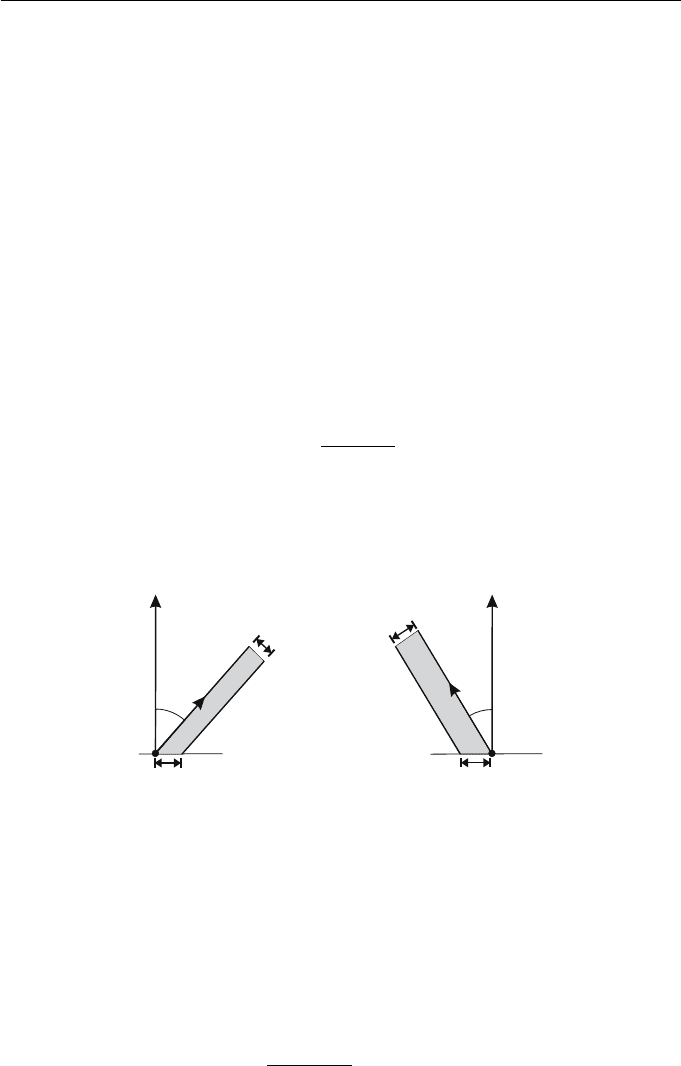
11. Rendering 301
rough so that light has an equal chance of being reflected in every direction.
Such surfaces are referred to as Lambertian surfaces as they satisfy Lambert’s
Law:
Lambert’s Law:Letφ be the angle between the surface normal and the view di-
rection. Then the intensity of light reflected in the view direction is directly
proportional to cos φ.
Note that intensity is defined to be the amount of light energy per unit of area.
Consider a narrow beam of light, of intensity
ˆ
I, shining on an area of ∆A of
an objects’s surface. An application of elementary trigonometry, yields that the
light reflected from the area ∆A is directed towards the viewer (in the direc-
tion V) as a beam of area cos φ∆A as indicated in Figure 11.3(a). Therefore,
the reflected beam has light energy
ˆ
I∆A acting on an area cos φ∆A. Then,
Lambert’s Law implies that the intensity of the reflected light is
I =cosφ
ˆ
I∆A
cos φ∆A
=
ˆ
I.
It can be concluded that the intensity of the reflected light is independent of
the view direction.
L
q
N
DA
DA/cos q
V
cos f DA
N
DA
f
(a) (b)
Figure 11.3
To compute the intensity I, consider a narrow beam of light with direction
L and area ∆A. Suppose that the angle of incidence is θ, and that the intensity
of the light source is I
d
. Then, by elementary trigonometry, the beam covers an
area ∆A/ cos θ as shown in Figure 11.3(b). Hence, the beam has energy I
d
∆A
acting on an area ∆A/ cos θ, giving
I = R
d
I
d
∆A
∆A/ cos θ
= I
d
R
d
cos θ.
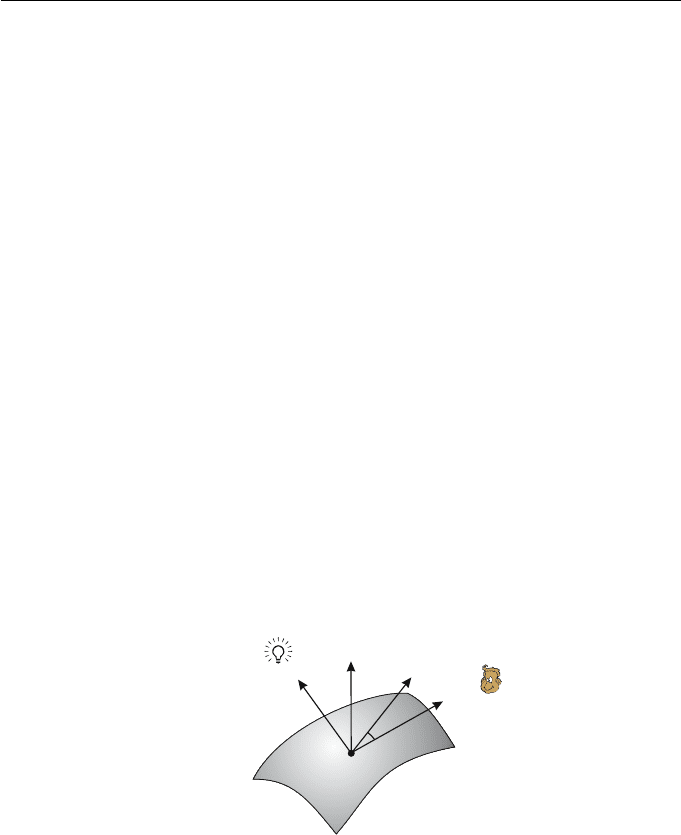
302 Applied Geometry for Computer Graphics and CAD
where 0 ≤ R
d
≤ 1isthecoefficient of diffuse reflection that specifies the
proportion of light reflected by the surface material of the object. If the ray of
light makes an angle of incidence that is greater than π/2, then the light is cast
from behind the surface. Therefore, the ray does not illuminate the surface,
and the surface is said to be self-occluding.
Finally, if N is the unit normal to the surface, and L is the unit vector
pointing to the light source, then cos θ = N · L. The reflected diffuse intensity
I
D
is given by
I
D
= I
d
R
d
cos θ = I
d
R
d
(N · L) , (11.2)
where 0 ≤ θ ≤ π/2, and 0 ≤ R
d
≤ 1. The colour of reflected diffuse light is the
colour of the object. Maximum reflected intensity is obtained when N · L =1
which occurs when the light ray is perpendicular to the object’s surface, that
is, parallel to the surface normal.
11.3.2 Specular Reflection
Specular reflection is obtained when light from a point source is reflected at
a certain angle from a shiny surface. The colour of specular reflection is equal
to the colour of the light source. Unlike diffuse reflection, specular reflection is
dependent on the position of the viewer.
N
L
P
R
V
a
Figure 11.4
Referring to Figure 11.4, let V be the unit vector in the direction from a
surface point P to the viewpoint. (Note that, for a fixed finite viewpoint, the
vector V is dependent on P.) Further, let α be the angle between V and the
(unit) reflected light ray R. Then, cos α = V · R. If the object is made from a
material that is perfectly reflecting, then the specular reflections have direction
R and are visible only when R = V and α = 0. In reality, however, there are
specular reflections in a range of angles about R. The intensity of reflected
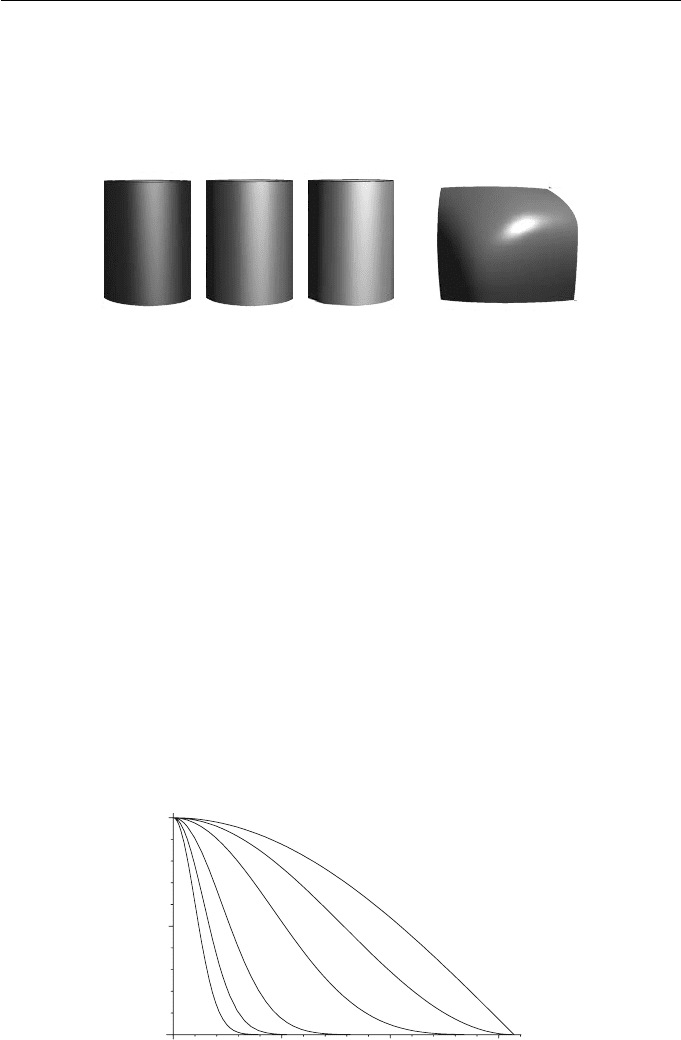
11. Rendering 303
light that the eye receives depends on α, and is such that smaller angles yield
greater intensities. This results in a region of the surface with higher intensities
called a specular highlight or hotspot as illustrated in Figure 11.5.
Figure 11.5 Specular highlights
A model for specular reflection, based on empirical findings, has been in-
troduced by Phong [19] and assumes that the intensity of specular reflection is
proportional to cos
m
α, for some positive number m. The graphs of cos
m
α for
various values of m can be seen in Figure 11.6. The cosine functions provide
reasonable profiles of intensity: values close to 1 for small angles, and rapidly
decreasing values as the angle increases. Let θ continue to denote the angle of
incidence. Then, using the fact that cos α = V · R, the specular intensity is
given by
I
S
= I
s
R
s
(θ)cos
m
α = I
s
R
s
(θ)(V · R)
m
, (11.3)
where 0 ≤ R
s
(θ) ≤ 1isthecoefficient of specular reflectance for the surface.
Note that R
s
(θ) is dependent on the angle θ and is governed by the material
properties of the surface. The function R
s
(θ) should be non-decreasing with in-
creasing θ. One obvious simplification of (11.3) is to assume that the coefficient
of specular reflectance is constant: R
s
(θ)=R
s
.
0
0.5
1
0.5 1 1.5
m=1
m=2
m=5
m=20
m=50
m=100
0
a
Figure 11.6 cos
m
α for various m
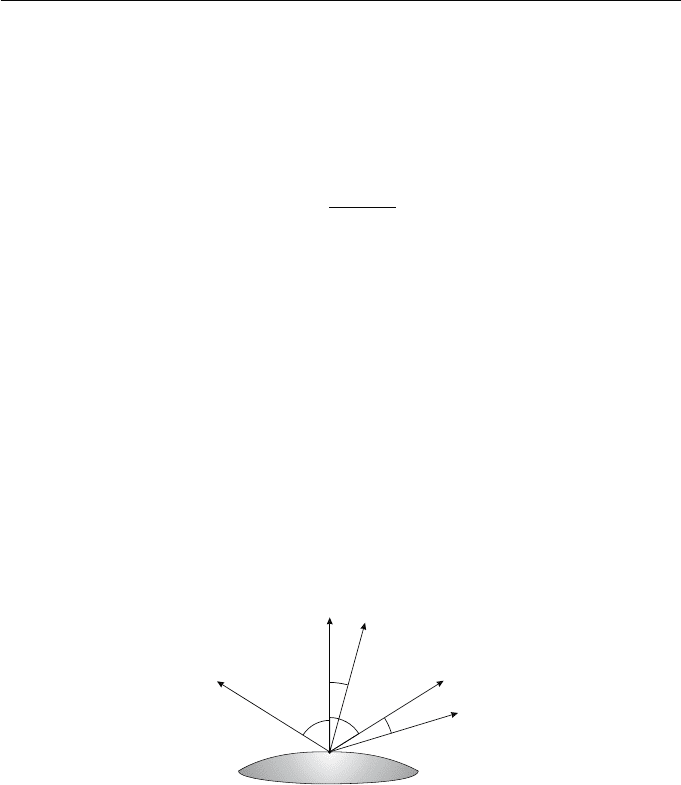
304 Applied Geometry for Computer Graphics and CAD
When the light source is distant, it can be assumed that the light rays are
parallel, and that L is constant. A further simplification is to assume that the
viewpoint is at infinity so that V is constant. With both of these assumptions,
Equation (11.3) can be modified to give an alternative model for which the
computation of intensities is more efficient. Let
B =
V + L
|V + L|
(11.4)
be the unit vector shown in Figure 11.7. Let β be the angle between N and
B so that cos β = N · B.(WhenV lies in the plane of N and L it is easily
shown that β = α/2.) The modified model for specular intensities is obtained
by replacing V · R by N · B in (11.3) to give
I
S
= I
s
R
s
(θ)(N · B)
m
. (11.5)
The computation of B requires fewer arithmetic operations than the computa-
tion of R using (11.1). Further, B is constant, and so I
D
and I
S
are functions
of N. It should be noted that the two models (11.3) and (11.5) do not give
identical results. The intensities of the second model are those of a surface
with normal vector B and R = V, and therefore the resulting intensities are
maximal in the view direction.
q
q
L
R
N
B
V
a
a
Figure 11.7 B is cheaper to compute than R
11.3.3 Ambient Reflection
Ambient (or background) reflection is difficult to model due to the complexity
of multiple reflections from one object onto other. A simple model of ambient
lighting is obtained by assuming that every object receives the same amount
of light from all directions. The colour of reflected ambient light is the same as

11. Rendering 305
the colour of the object. If the uniform intensity of ambient light is I
a
,then
the reflected ambient intensity of an object is given by
I
A
= I
a
R
a
, (11.6)
where 0 ≤ R
a
≤ 1 is the coefficient of ambient reflection. The value of R
a
is dependent on the material characteristics of the object. When R
a
=0the
object produces no reflected light, and when R
a
= 1 the object reflects light at
full intensity.
11.3.4 Attenuation
When a light source is a finite distance from the objects in a scene, the distance
between the objects and the light source should be considered. The brightness
of reflected light is inversely proportional to the square of the distance d of the
object to the light source. This means that each reflected intensity should be
multiplied by an attenuation factor att(d)=1/d
2
giving
I
D
= att(d)I
d
R
d
cos θ = att(d)I
d
R
d
(N · L) , and
I
S
= att(d)I
s
R
s
(θ)(N · B)
m
.
In practice the formulae give poor results for non-point light sources, and an
adapted multiplier
att(d)=
1
a
2
d
2
+ a
1
d + a
0
is more commonly used (with a
0
= 0 to prevent a divide by zero). The pres-
ence of the quadratic term can cause a wide range of intensity values so many
applications set a
2
= 0 to give att(d)=1/(a
1
d + a
0
), or ignore attenuation
completely (att(d) = 1). An alternative is to cap the attenuation at a certain
value to remove the possibility of extreme values.
11.3.5 Total Intensity
The reflection model is completed by combining the ambient intensity, with the
diffuse and specular intensities for each light source, to give the total intensity
I = I
a
R
a
+ att(d)
i
(I
d
R
d
(N · L
i
)+I
s
R
s
(θ)(N · B
i
)
m
) , (11.7)
where
i
denotes summing over all light sources.
For a colour rendering device, the intensity formula (11.7) is applied to each
colour component and combined to give a colour intensity. For example, suppose

306 Applied Geometry for Computer Graphics and CAD
a device uses an RGB model. Then it is necessary to specify the coefficients
of reflection and intensities for each colour component. For compactness, let
the red, green and blue coefficients of ambient reflectance be represented by
the vector R
a
=(R
a,r
,R
a,g
,R
a,b
). Similarly, let the coefficients of diffuse and
specular reflectance be R
d
=(R
d,r
,R
d,g
,R
d,b
)andR
s
=(R
s,r
,R
s,g
,R
s,b
),
respectively. Further, let the ambient, diffuse, and specular intensities be I
a
=
(I
a,r
,I
a,g
,I
a,b
), I
d
=(I
d,r
,I
d,g
,I
d,b
), and I
s
=(I
s,r
,I
s,g
,I
s,b
). Then the total
intensity for red is
I
red
= I
a,r
R
a,r
+ att(d)
i
(I
d,r
R
d,r
(N · L
i
)+I
s,r
R
s,r
(θ)(N · B
i
)
m
) . (11.8)
There are similar equations for green and blue.
11.4 Shading Algorithms
The illumination model discussed in Section 11.3 determines the colour in-
tensity of a point of an object surface. Shading algorithms determine how the
illumination model is applied across the entire surface. Ideally, intensities would
be calculated at every visible point of every surface in the scene (and computed
to the resolution of the display device). This is not feasible since each point
intensity calculation requires a surface unit normal to be computed, and this
entails expensive surface derivative evaluations and the application of a square
root (see Equation (9.1)). Therefore it is important to implement shading algo-
rithms in a manner that minimises the number of intensity and surface normal
computations.
The shading algorithms described in the following sections require the object
surfaces to be faceted, that is, approximated by a mesh of planar polygonal faces
or facets. A simple way to facet a surface S(u, v) is to evaluate along the u and v
parameter lines to give a rectangular grid of points P
i,j
= S(u
i
,v
j
)for0≤ i ≤
m and 0 ≤ j ≤ n. Triangular facets can be obtained by splitting the polygon
with vertices P
i,j
, P
i+1,j
, P
i,j+1
, P
i+1,j+1
into two triangles. More elaborate
faceting methods take the curvature of the surface into account in order to
obtain many facets in regions where the surface bends the most, and few facets
where the surface is flat. B´ezier and B-spline surfaces can be faceted using the
subdivision methods of Section 9.5. If the surface is subdivided sufficiently, then
the control polygon can be used to obtain facets.
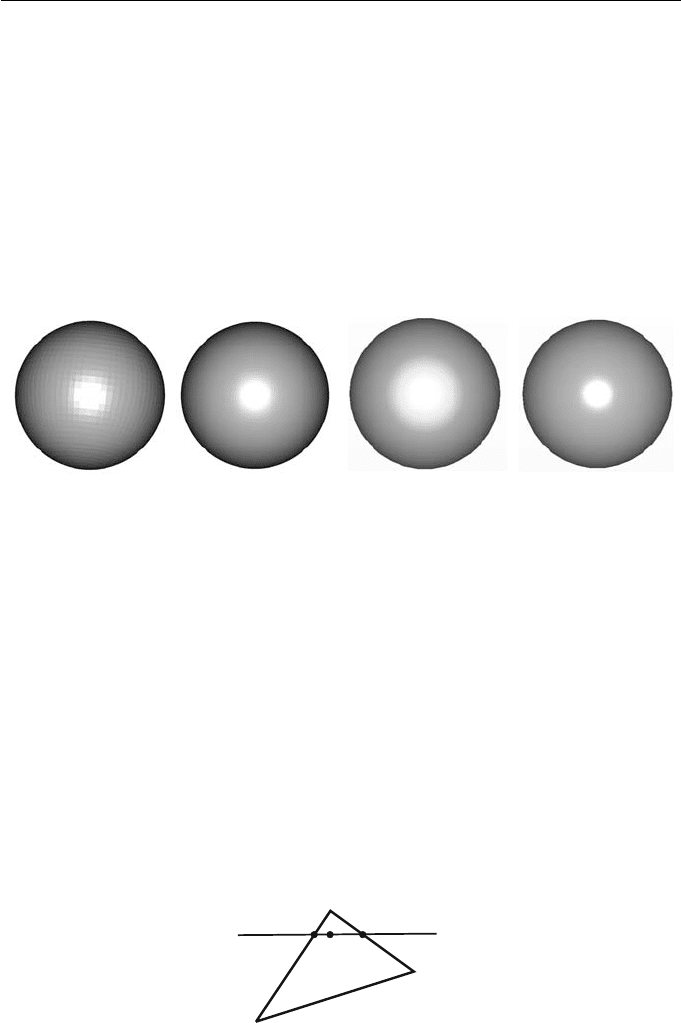
11. Rendering 307
11.4.1 Flat Shading
The flat shading algorithm assigns one colour intensity value uniformly across
each facet. This gives a very cheap shading method as the intensity is computed
at just one point of each facet. However, since adjacent facets have different
intensities the facets are clearly distinguishable, and the lack of variation in the
shading makes the facets look flat. The facets of the sphere in Figure 11.8(a)
are fairly pronounced. Better shading can be obtained by taking very small
facets as shown in Figure 11.8(b).
(a) (b) (c) (d)
Figure 11.8 Renderings of a sphere
11.4.2 Gouraud Shading
Gouraud shading tries to overcome the unnatural uniform intensity of the flat
shading method. The illumination model (11.7) is used to determine the colour
intensities of the vertices of each triangular facet of the surface. Then, the inten-
sities of each vertex are interpolated to give approximate intensities for other
points of the facet. The variation in intensities provided by the interpolation
reduces the flat appearance of the facet.
A
B
C
L
M
l
P
Figure 11.9 Intensity calculation using a scanline
